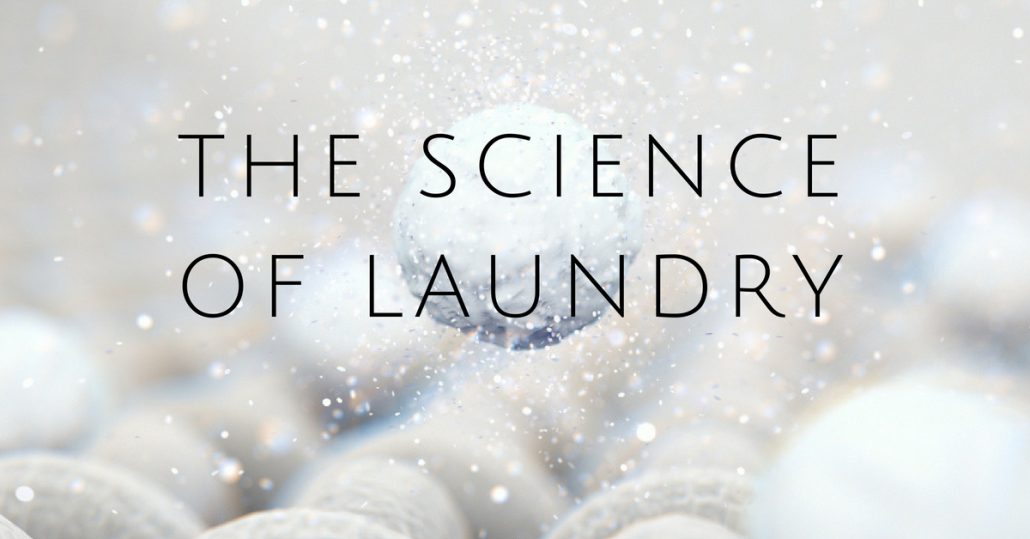The Science of Laundry
Written by Hannah Villarba
If you’re feeling a little down and the world seems to be giving you nothing but things to complain about, here’s one major thing to be thankful for: modern-day laundry. It does not sound like much, but considering that the human civilization started with urine as one of its very first cleaning agents, the laundry process we use today is a massive upgrade.
On the surface, washing clothes is pretty straightforward. You just need three essential things: detergent, water, and a machine. But on a deeper molecular level, there’s a larger and more complex science that operates. Understanding this process not only helps you achieve better and cleaner results with every load, but it also helps you prolong your garments’ lifespan and do so more efficiently.
The Science of Laundry: A Breakdown of Elements
To understand the science that goes on with every wash cycle, let’s break down each of its components and see how these elements work and how they contribute to the overall result of each wash.
1. Detergent
Detergent is tasked with the main job of removing dirt, grime, grease, and other impurities that have adhered to fabric. While every detergent brand boasts of different ingredients, all claiming to be better than the others, the cornerstone of all laundry detergents are the careful combination of things called surfactants, water conditioners, and enzymes.
Surfactants are easily the most important ingredient in a detergent, although it takes a lot more than these surfactants to completely clean fabrics. Surfactants are a chemical chain of hydrophobic (water-hating) and hydrophilic (water-loving) molecules that look a little something like this. This chemical composition allows for the surfactants to do two things in laundry: the hydrophobic end of the molecule clings onto greasy particles on the fabric while the hydrophilic molecules cling to the surrounding water molecules. The agitation in the washing machine causes the water molecules – now attached to the hydrophilic end of the surfactants – to pull on the surfactants and the grease attached on the hydrophobic end of the surfactant’s molecule chain.
Enzymes are a combination of active chemicals that help break apart stains. Different types of enzymes target different types of stains: proteases for protein-based stains, amylases for starch and lipases for grease. Water and surfactants alone can only do so much, hence the enzymes, normally a combination of two or all three types in most brands of detergents, break down the stains into smaller particles that the surfactants can cling to and effectively pull out of the fabric fibers.
Water conditioners are designed to make the water conducive for washing. From the source, water picks up different minerals, chalk, and certain metals, among other things, along the way to the tap. While this type of water – also known as hard water – is great for drinking for its substantial magnesium and calcium components, these exact elements in hard water interfere with the cleaning action of surfactants, rendering them less effective and leaving an unsightly discoloration on the fabric. Water conditioners in detergent attract and bind these minerals and metals so the surfactant can do its job without any interference. Hard water, therefore, requires more water conditioners to work more effectively. Traditionally, detergents use sodium triphosphate, a naturally-occurring chemical, as water conditioner. However, sodium triphosphate has been found to cause excessive algal growth that chokes rivers.
Other elements found in laundry detergent include perfumes, peroxide, or bleach, which is known for its disinfecting qualities as well as for removing stains by breaking down the dye bonds in fabric.
2. Water
Water is the main activator of detergent’s main stain-removing ingredients. Aside from the presence (or absence) of minerals and metals, which we have mentioned earlier, the temperature of the washing water also plays a major role in how well your linens are cleaned. The temperature of the water plays a role not only in the elimination of germs in the laundry but more so in how it helps speed up the chemical reaction during the wash process. This is due to two main reasons: one is the fact that higher temperature water molecules move at a more rapid rate than cold water; and two, the enzymes that break down stains (i.e. proteases that break down protein stains) work in temperature-controlled environments, proving ineffective in too high or too low numbers.
Water temperature also affects types of fabrics differently. Certain fabrics shrink in hot water while others bleed ink in cold water. The reaction varies, hence the importance of reading and following label instructions carefully to prevent damaging clothing fibers.
3. Washing Machines
Washing machines provide the one factor that allows the cleaning forces of water and detergent to work together. Through its agitators (for top-loading machines) or paddles (for front-loading machines), the movements inside the washing machine create the friction needed to loosen the dirt and help speed up the process of the molecules at work.
At Linen Finder, we understand how important it is to work with a linen service provider that you trust, which is why we only work with companies that have laundry down to a science. Contact us today to get started with a linen or uniform service that exceeds your highest expectations!

